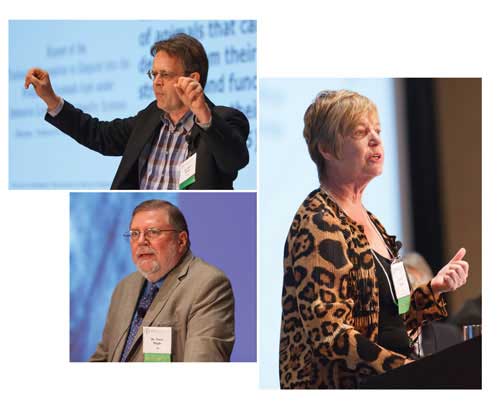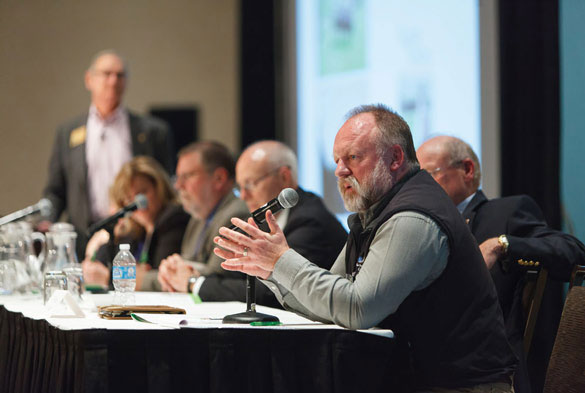The Conversation

Right: Janice Swanson, PhD,Department of Animal Science chair, Michigan State University
Bottom left: Terry Maple, PhD, professor in residence,San Francisco Zoo
Public concern over the treatment of animals has been growing for decades. Long-accepted practices of animal husbandry and use are being challenged, particularly in the areas of agriculture, research, and entertainment. People are more sympathetic to the view that animals are not “things” but sentient creatures whose interests are worthy of equal consideration.
In 2008, the AVMA Executive Board staked out a position opposing ear cropping and tail docking in dogs for cosmetic reasons. Four years later, the board supported federal legislation requiring larger housing for millions of layer hens. The board explained in both instances it was acting in the best interests of the animals. And, while many veterinarians agreed with the AVMA, others did not.
Animal welfare is a complex, emotionladen field prone to contentiousness. As the previous examples of ear cropping and tail docking in dogs and housing of layer hens demonstrate, veterinarians aren’t immune to disagreements over what constitutes good welfare. At times when such infighting spills into the public arena, the veterinary profession’s message and image as animal welfare leaders can be compromised, however.
With a goal of managing future intraprofessional conflicts, the AVMA recently brought a select group of some 150 veterinarians with diverse professional backgrounds to Chicago to add to their animal welfare knowledge as well as learn problem-solving and consensus-building skills.
(I)f we want to be a constructive part of that conversation with society, we can’t hide behind science. Science informs decisions; it doesn’t make decisions.
Dr. Douglas G. Aspros, AVMA immediate past president"
The conference, titled “Can You Hear Me Now? The Conversation,” was held Nov. 14-15, 2013, and featured a group of internationally renowned veterinarians, animal scientists, and ethicists who spent the first day presenting the scientific, social, political, market, and legal aspects of how and why animal welfare decisions are made. The next day, attendees split into small groups to conduct welfare assessments on captive elephant handling; feral and owned free-roaming cats; housing for egg-laying hens and feral horses; and the use of rats in multiple sclerosis research.
“This was not a conversation between veterinarians and the general public. This was a conversation between veterinarians and other veterinarians,” Dr. J. Bruce Nixon, chair of The Conversation Working Group, explained. He said this group was restricted to veterinarians, because they need to learn how to discuss these things internally before turning to external discussions.
One of the architects of The Conversation, AVMA Immediate Past President Douglas G. Aspros, said animal welfare issues have been among the most contentious he’s dealt with as an Executive Board member. His vision for the conference was to bring together AVMA members with diverse professional backgrounds to start a dialogue about how veterinarians can, together, advance animal welfare, despite differences in professional responsibilities and perspectives.
“It was exciting to have that kind of diversity within the profession in the room,” Dr. Aspros said. “There were people who manifestly did not agree, and yet, we talked through issues and were colleagues. That’s at the heart of what AVMA is about.”
Several speakers highlighted the inherent tensions of a profession that cares for animals but also facilitates the responsible use of animals to satisfy human interests and needs. Those tensions are nowhere more evident than in laboratory animal medicine. Dr. Steven Niemi, director of the Office of Animal Resources at Harvard University, put it this way: “Laboratory animal medicine is a hard field and is probably the hardest to handle in the entire veterinary profession. We’re the only ones who intentionally inflict pain on animals for a higher good.”
These dual loyalties can sometimes make it difficult for veterinarians to communicate with the public, according to Candace Croney, PhD, an associate professor of animal behavior and well-being at Purdue University. “Veterinary medicine lacks a cohesive message on animals. On the one hand, they’re family members. On the other, they’re commodities,” Dr. Croney said.

Dr. Aspros believes learning how to disagree while remaining unified is critical not only to the AVMA as an organization but to the veterinary profession as well. “It’s very important for AVMA to continue to be the big tent,” he said. “It’s important organizationally, but it’s also important for the profession as a whole to have a unified, strong voice. Nobody else in the profession can play that role. So it’s important for AVMA to hold together at times when everybody doesn’t agree.”
Some members have suggested the AVMA should be a resource on animal welfare science and no longer take a position on whether a particular practice is good or bad. Dr. Aspros disagrees, saying veterinarians shouldn’t forfeit their role as animal welfare leaders. “At the end of the day, if we want to be a constructive part of that conversation with society, we can’t hide behind science. Science informs decisions; it doesn’t make decisions,” he said.
The Conversation Working Group is exploring the option of condensing the lectures and welfare assessments into a “mini The Conversation” format for veterinary colleges and associations.
Related JAVMA content:
Symposium brings together leaders in animal welfare (Jan. 15, 2010)
AVMA opposes cosmetic ear cropping, tail docking of dogs (Dec. 15, 2008)
Congress considers US egg production standards (March 15, 2012)